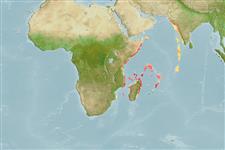Классификация / Names
народные названия | синонимы | Catalog of Fishes(род, виды) | ITIS | CoL | WoRMS | Cloffa
>
Aulopiformes (Grinners) >
Synodontidae (Lizardfishes) > Synodontinae
Etymology: Synodus: Greek, syn, symphysis = grown together + Greek, odous = teeth (Ref. 45335); vityazi: Named for the research vessel Vityaz II, for its great contribution to deep-sea fish research and for collecting the type series described in present study.
Eponymy: The Russian Research Vessel ‘Vityaz’ (also spelled Vitiaz) is famous for many cruises, during which the holotypes of several of the above fish were caught. [...] (Ref. 128868), visit book page.
Environment: milieu / climate zone / пределы глубины / distribution range
экология
морской донно-пелагический; пределы глубины 36 - 40 m (Ref. 84021). Tropical
Western Indian Ocean: Northeast Madagascar.
Size / Вес / Возраст
половая зрелость: Lm ? range ? - ? cm
Max length : 13.1 cm SL самец/пол неопределен; (Ref. 84021)
Краткое описание
определительные ключи | морфология | морфометрия
членистые (мягкие) лучи спинного плавника (общее число) : 12 - 13; членистые (мягкие) лучи анального плавника: 9 - 10; позвонки: 56 - 57. This species is distinguished by the following combination of characters: D 12-13; A 9-10; pectoral rays 12-13; lateral line scales 56-58; scales between lateral line and base of dorsal fin 3.5; median predorsal scales 16-17; vertebrae 56-57; peritoneal spots 8; anterior palatine teeth not longer than posterior teeth; preopercle scaled posterior to corner of mouth; membranous posterior flap of anterior nostril slender, with a pointed tip, reaching to above posterior nostril when laid back; pectoral fins reaching a line connecting dorsal and pelvic fin origins, fin length 2.3-2.6 in head length; pelvic processes wedge-shaped, broad at base; color in alcohol with no marking, deep brown on dorsal surface restricted to central two-third of head and body longitudinally, about 2 scale rows above the lateral line, lateral and ventral surface uniformly silvery white without any blotch; all fins colorless, except for inner edge of caudal fin fork that is black (Ref. 84021).
Body shape (shape guide): elongated.
Life cycle and mating behavior
половая зрелость | размножение | нерест | икра | Fecundity | личинки
Ho, H.-C., A.M. Prokofiev and K.-T. Shao, 2010. Synodus cresseyi Prokofiev, 2008, an unnecessary replacement for S. macrocephalus Cressey, 1981, and a description of a new species from the Western Indian Ocean (Teleostei: Synodontidae). Zootaxa 2419:63-68. (Ref. 84021)
Статус Красного Списка МСОП (Ref. 130435: Version 2025-1)
Угроза для людей
Harmless
Использование человеком
дополнительная информация
инструменты
Специальные отчеты
Скачать в формате XML
ресурсы в Интернет
Estimates based on models
Preferred temperature (ссылка
123201): 21.3 - 26.7, mean 25.2 °C (based on 25 cells).
Phylogenetic diversity index (ссылка
82804): PD
50 = 0.5000 [Uniqueness, from 0.5 = low to 2.0 = high].
Bayesian length-weight: a=0.00457 (0.00221 - 0.00945), b=3.16 (2.99 - 3.33), in cm total length, based on LWR estimates for this Genus-body shape (Ref.
93245).
Trophic level (ссылка
69278): 3.9 ±0.7 se; based on size and trophs of closest relatives
устойчивость к внешним воздействиям (ссылка
120179): высокий, минимальное время удвоения популяции до 15 месяцев (Preliminary K or Fecundity.).
Fishing Vulnerability (Ref.
59153): Low vulnerability (10 of 100).
🛈
